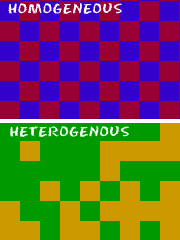Hey
Guys! It's Teemster again! Did you guys like my last post? Hopefully you did! Anyway, lets get to science. That’s why you’re
reading this, right? Well, for this post I'm going to talk about Compounds and
Mixtures.
Well, as you may or may not know, compounds and mixtures are very different.
I’ll start with compounds.
With compounds, different things come together and make a chemical change. A
compound is made when toms of two or more elements bond in a chemical reaction.
Elements and other compounds reacting can also form compounds. That being said,
some compounds can be broken down into simpler compounds. After the chemical
reaction, the elements don’t look anything like their original element from
before. The chemical reaction causes the elements to change forms and from a
new compound. An example of a compound is Salt. You know, that thing that is
usually on the table at restaurants (I said usually because the salt isn't
always there, and those are the times I need salt for my food! I hate it when
that happens!). Table salt is TaCl. Ta is Natrium (Sodium), and Cl is for
chlorine. Together, there is a chemical reaction, and Poof! There you go. Now
you have table salt!
Once the reaction happens, it is nearly impossible to undo. Did you get
that? Yes? Yay! Wait… No? Oh well, moving on.
So, did that make sense? Okay, good. (She says hoping that it made sense to
you…) Well, now you know about compounds! Are you ready to learn about mixtures? Well, you are
going to anyway so that shouldn’t even be a question. A mixture is
formed when two or more elements, or compounds, are blended without combining
chemically. They are combined physically, unlike compounds. When the substances
are combined, they keep their own properties. Its like a salad! The
lettuce, croutons, dressing, and anything else keep its properties, but it’s
still mixed together. Even thought it is still mixed together, using physical
or mechanical means can still separate it. Liquids, solids, and gases can be
blended into heterogeneous or
homogeneous mixtures. A homogeneous mixture is a mixture that is
combined completely. You could think of it this way! You know those flavorings
for water bottles? Well, when you combine that and the actual water, it
dissolves together. That’s one example of a homogeneous mixture. A
heterogeneous mixture is when the substances don’t completely combine together.
The particles can be distinguished by the human eye, unlike in a homogeneous
mixture. An example of this one is a regular bowl of fruit loops! The bits of
cereal float around in a bowl of milk! You probably didn’t expect that, huh?
Well, That's it for today! Bye! :D
Did you
like my second blog? Tell me your feedback
please! I'm still hoping you got this blog! :P
please! I'm still hoping you got this blog! :P
Don't
worry, I can take some negative reviews...
*Says,
but still hoping that there aren't any*
xoxo Teemster! :D
P.S. Orange words are links to information
and yellow are links for my pics! :D
P.S. Orange words are links to information
and yellow are links for my pics! :D




No comments:
Post a Comment